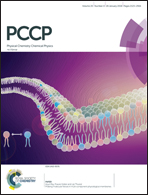Charge separation properties of Ta3N5 photoanodes synthesized via a simple metal–organic-precursor decomposition process†
Abstract
Here, we successfully synthesized a Ta3N5 thin film using a simple metal–organic-precursor decomposition process followed by its conversion to nitride and studied its photoelectrochemical (PEC) properties to understand charge separation on the surface. Newly synthesized Ta3N5 photoanodes showed a significant difference in the PEC activity in relation to the annealing temperature under ammonia flow, although similar light absorption properties or electronic states were obtained. Charge separation related PEC properties were analyzed using intensity modulated photocurrent density spectroscopy (IMPS) and photocurrent measurements in the absence/presence of scavengers. The charge transfer and recombination rate constants which are related to the photogenerated charge-separation dynamics on the Ta3N5 surface were found to be more sensitively influenced by the ammonia annealing temperatures, and low temperature (700 °C) treated Ta3N5 showed a fast recombination rate constant (kr). In addition, high-efficiency charge injection into the electrolyte on the surface was critically associated with the greatly enhanced photocurrent density of Ta3N5 synthesized at a higher temperature (900 °C) of ammonia annealing.



 Please wait while we load your content...
Please wait while we load your content...